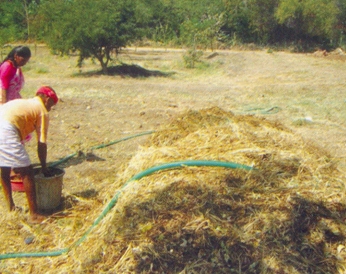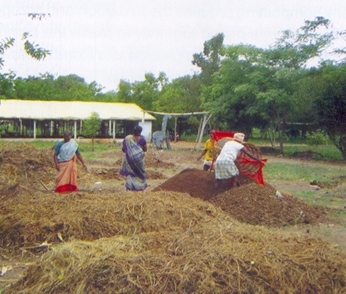 |
|||||||||||||||||||||||||||||||||||||||||||||||||||||||||||||||||||||||||||||||||||||||||||||||||||||||||||||||||||||||||||||
| Organic Farming :: Compost | |||||||||||||||||||||||||||||||||||||||||||||||||||||||||||||||||||||||||||||||||||||||||||||||||||||||||||||||||||||||||||||
Crop Residue Composting Crop residues are the non-economic plant parts that are left in the field after harvest. The harvest refuses include straws, stubble, stover and haulms of different crops. Crop remains are also from thrashing sheds or that are discarded during crop processing. This includes process wastes like groundnut shell, oil cakes, rice husks and cobs of maize, sorghum and cumbu. The greatest potential as a biomass resource appears to be from the field residues of sorghum, maize, soybean, cotton, sugarcane etc. In Tamil Nadu 190lakh tones of crop residues are available for use. These residues will contribute 1.0 lakh ton of nitrogen, 0.5 lakh ton of phosphorusand2.0 lakh tons of potassium. How ever crop residues need composting before being used as manure. Waste collection Crop residues accumulated in different locations are to be brought to compost yard. The compost yard is located in anyone corner of the farm with accessibility via good road. Water resource should also be available in sufficient quantity. The crop residues that are brought to compost yard should be heaped in one corner for further processing. Shredding of waste materials Particle size is one of the factors that influence the composting. It is advisable to shred all the crop residues that are used for composting. Shredding the waste manually is labour intensive. Shredder machine can be employed to shred all the crop residue biomass. Particle size of 2 to 2.5 cm is recommended for quick composting. Mixing of green waste and brown waste Carbon and nitrogen ratio decides the initiation of composting process. If C:N ratio is wide (100:1) composting will not take place. Narrow C:N ratio of 30:1 is ideal for composting. To get a narrow C:N ratio, carbon and nitrogen rich material should be mixed together. Green coloured waste materials like glyricidia leaves, parthenium, freshly harvested weeds; sesbania leaves are rich in nitrogen, whereas brown coloured waste material like straw, coir dust, dried leaves and dried grasses are rich in carbon. In any composting process these carbon and nitrogen rich material is to be mixed together to make the composting quicker rather than putting green waste alone or brown color waste alone for composting. Animal dung is also a good source of nitrogen. While making heap formation, alternative layers of carbon rich material, animal dung and nitrogen rich material are to be heaped to get a quicker result in composting. Compost heap formation Minimum 4 feet height should be maintained for composting. The composting area should be elevated one and have sufficient shade. While heap formation, all the crop residues should be mixed together to form a heterogeneous material rather than a single homogenous material. Alternate layers of carbon and nitrogen rich material with intermittent layers of animal dung are essential. After heap formation the material should be thoroughly moistened. Bioinputs for composting TNAU Biomineralizer consortium contains groups of microorganisms, which accelerate the composting process. If this inoculum is not added to the composting material, natural microorganisms establish on the waste material on its own and do the composting work. This process takes longtime. But if external source of inoculums is added, the microbial activity starts earlier and composting period will be reduced. For one ton of crop wastes 2 kg of TNAU Biomineralizer is recommended. This two kg Biomineralizer should be mixed with 20 liters of water and made slurry. When the compost heap is formed in between layers the slurry should be inoculated, so that it mixes with the waste material thoroughly for uniform coating of microorganism on the waste material. Cow dung slurry is also a good source for microbial inoculum. But it carries unwanted microorganisms also which may compete with composting organism. But when TNAU Biomineralizer is not available, cow dung slurry is a good source material. For one ton crop residues40 kg fresh cow dung is required. This 40 kg fresh cow dung is mixed with 100litres of water and it should be thoroughly poured over the waste material. Cow dung slurry acts as nitrogen source as well as source of microbial inoculum.
Aerating the compost material Sufficient quantity of oxygen should be available inside the compost heap. For this external air should be freely get in and comes out of the material. Normally to allow the fresh air to get inside, the compost heap should be turned upside down, once in fifteen days. In this process top layer comes to bottom and bottom layer goes to top. This process also activates the microbial process and compost process is hastened. In some cases air ventilating pipe maybe inserted vertically and horizontally, to allow the air to pass through. The wood chip that is available as waste in wood processing industry may also be used as bulking agent in the composting process. This bulking agent gives more air space to the compost material. Moisture maintenance Throughout the composting period 60% moisture should be maintained. On any situation, compost material should not be allowed to dry. If the material becomes dry, all the microorganisms present in the crop residues will die and the compost process gets affected. Compost maturity Volume reduction, black colour, earthy odor, reduction in particle size are all the physical factors to be observed for compost maturity. After satisfying with the compost maturity index, the compost heap can be disturbed and spread on the floor for curing. After curing for one day, the composted material is sieved through 4 mm sieve to get uniform composted material. The residues collected after composting has to be again composted to finish the composting process. Compost enrichment The harvested compost should be heaped in a shade, preferably on a hard floor. The beneficial microorganisms like Azotobacter or Azospirillum, Pseudomonas, Phosphobacteria (0.2%) and rock phosphate (2%) have to be inoculated for one ton of compost. Forty per cent moisture should be maintained for the maximum growth of inoculated microorganism. This incubation should be allowed for 20 days for the organism to reach the maximum population. Now the compost is called as enriched compost. The advantage of enriched compost over normal compost is the quality manure with higher nutrient status with high number of beneficial microorganisms and plant growth promoting substances. Nutritive value of Biocompost The nutritive value of Biocompost varies from lot to lot because of varying input materials. But in general Biocompost contains all the macro and micro nutrients required for crops, which is given in the following table. Even though the quantity available is low it covers all the requirements of the crop. Nutrient content of biocompost prepared from different crop residues
The common manurial value of different biocompost prepared from different substrate is given below. Benefits of Biocompost
Compost application Organic manures are highly regarded as good source of material to maintain soil health and increasing soil organic carbon content. Organic manures cannot be equated with inorganic fertilizers. But organic manures deliver all the nutrients to the soil but with little quantity. For one hectare of land 5 tons of enriched biocompost is recommended. It can be used as basal application in the field before taking up planting work. Limitation in Biocompost application
|
|||||||||||||||||||||||||||||||||||||||||||||||||||||||||||||||||||||||||||||||||||||||||||||||||||||||||||||||||||||||||||||
Home | Schemes | Trainings | Related Information | Gallery | Contact | Disclaimer |
|||||||||||||||||||||||||||||||||||||||||||||||||||||||||||||||||||||||||||||||||||||||||||||||||||||||||||||||||||||||||||||
© TNAU 2008 - 2024 All Rights Reserved. |
|||||||||||||||||||||||||||||||||||||||||||||||||||||||||||||||||||||||||||||||||||||||||||||||||||||||||||||||||||||||||||||

